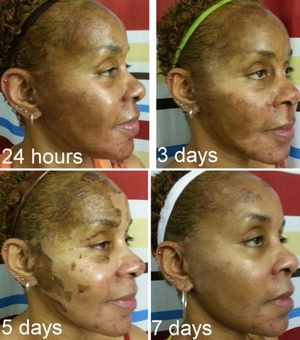- Monday – Saturday 9:00 AM – 6:00 PM
Our Services
Opening Hours
Contact Info
Our Locations
Abuja: No. 35 Pope John Paul II Street, Off Gana Street, Maitama, Abuja, Nigeria.Lagos: No. 8 Aromire Road (formerly Rumsey road), MTN area, Old Ikoyi, Lagos state.
Port Harcourt: No.12 Alalibo Avenue, Off Mbiama street, Old GRA, Port Harcourt, Rivers State
What is a Chemical Peel?
A chemical peel is a treatment in which an alpha or beta hydroxyle acid is applied to the skin with the aim of causing a very deep exfoliation that will result in the removal of the most superficial skin layers. This removal reveals new skin that is smoother and clearer.
What are Chemical Peels used for?
Chemical peels are useful in the:
- Treatment of certain types of acne
- Pigmentation problems
- To improve scarring
- In the treatment of wrinkles
- To generally rejuvenate skin.
Chemical peels are usually used with other modalities of treatment to hasten improvement, not as stand-alone treatments.
What are the types of Chemical peels?
Chemical peels are classified as superficial, medium or deep peels, depending on the depth of skin they reach. How drastic the results from a peel will be will depend on the depth of the peel. Superficial peels do not reach skin below the epidermis, the most superficial skin layer. Medium peels may reach the superficial layer of the dermis, the deeper layer of the skin. Deep peels generally reach the deeper layers of the dermis. The depth of peel depends on the nature and concentration of the acids in the peeling solution and the length of time they are permitted to interact with the skin.
But I heard peels can’t be done on Skin of Color.
All skin types and tones can benefit immensely from chemical peels, depending on the choice of peel and the pre and post peel management. For Skin of color, we restrict the choice of peels to superficial and medium depth. To therefore get the same or similar benefits we would from a single deep peel, we normally need to do multiple, consecutive superficial or medium depth peels. A minimum of 3 peels every 1 to 2 weeks is the typical recommendation, requiring more or less depending on the results achieved.
At our facility we have a wide variety of medical grade peels of various strengths, including but not limited to azelaic acid, Lactic acid, glycolic acid, salicylic acid, mandelic acid, jessner’s solution, combination peels like the obagi blue peel, VIPeel, melanopeel and many others. We work with our patients, explaining the benefits of each peel and our reasons for recommending one over the other for the condition being managed.
Before getting a peel, we would commence a pre peel regimen, aimed at maximizing results and minimizing side effects. The pre-peel regimen includes:
- Commencing the use of strict broad spectrum sun protection, a minimum of SPF30. It is recommended that sun protection be reapplied every 3 to 4 hours.
- Commencing the use of a skin lightening agent. This along with the sun protection reduces the activity of the pigment cells, minimizing the chance of dark patches and discoloration following the peel.
- Anti-viral drugs if you have a history of recurrent sores/ fever blisters.
- Cessation of any drugs that increase your skin’s sensitivity to the sun.
The procedure itself lasts a few minutes. The skin will be cleansed and the solution applied. During the peel, you may feel a burning sensation or stinging lasting a few minutes. The contact time of the peel will depend on the type of peel, patient discomfort and how the skin responds to the peel.
After the peel, typically there would be redness followed by scaling within 3 to 7 days. A few people would blister, this would still scale off.

Here is an example of a patient that had a Jessner’s peel (photo credit)
What are the side effects of Chemical Peels?
Side effects that could come up following a peel include the reactivation of cold sores, scarring and discoloration. These are uncommon in adequately managed peeling situations and easily managed by your doctor.
